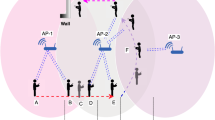Abstract
Since the advent of 1G through 5G networks, telecommunication industry has gone through phenomenal transformation in the way we communicate, we work, and we socialize. In dense or ultra-dense mobile communication networks, the users are very frequently handed over to other cells making seamless mobility a challenging and complex problem. Therefore, robust connectivity in such networks becomes a very critical issue. In this paper, we present a data-driven handover optimization approach aiming to mitigate the mobility problems including handover delay, early handover, wrong selection of target cell and frequent handover. The proposal is based on collecting the information from the network and developing a model to determine the relationship between the features drawn from the collected dataset and key performance indicator (KPI) expressed as the weighted average of mobility problem ratios. Handover design parameters- time to trigger and handover margin are optimized to improve KPI. The KPI estimation drawn on time to trigger and hysteresis margin design parameters is estimated through neural network multilayer perception method. It is established through simulation results that the proposed approach yields significantly improved handover performance mitigating mobility problem in ultra-dense cellular networks to notable extent.









Similar content being viewed by others
References
Andrews, J. G., Buzzi, S., Choi, W., Hanly, S. V., Lozano, A., Soong, A. C. K., et al. (2014). What will 5G be? IEEE Journal on Selected Areas in Communications, 32(6), 1065–1082.
Kitagawa, K., Komine, T., Yamamoto, T., & Konishi, S. (2011). A handover optimization algorithm with mobility robustness for LTE systems. In 2011 IEEE 22nd international symposium on personal, indoor and mobile radio communications (pp. 1647–1651), Toronto, ON, Canada.
Xenakis, D., Passas, N., Merakos, L., & Verikoukis, C. (2016). Handover decision for small cells: Algorithms, lessons learned and simulation study. Computer Networks, 100, 64–74.
Awada, A., Wegmann, B., Viering, I., & Klein, A. (2013). A SON-based algorithm for the optimization of inter-RAT handover parameters. IEEE Transactions on Vehicular Technology, 62(5), 1906–1923.
Singh, B., Aggarwal, K. K., & Kumar, S. (2004). Hysteresis plus timer based handover initiation algorithm for microcellular systems. IETE Technical Review, 21(3), 181–189.
Alsamhi, S. H., & Rajput, N. S. (2015). An intelligent hand-off algorithm to enhance quality of service in high altitude platforms using neural network. Wireless Personal Communications, 82(4), 2059–2073.
Alotaibi, N. M., & Alwakeel, S. S. (2015). A neural network based handover management strategy for heterogeneous networks. In 2015 IEEE 14th international conference on machine learning and applications (ICMLA) (pp. 1210–1214), Miami, FL, USA.
Jansen, T., Balan, I., Turk, J., Moerman, I., & Kurner, T. (2010). Handover parameter optimization in LTE self-organizing networks. In 2010 IEEE 72nd vehicular technology conference—Fall (pp. 1–5), Ottawa, ON, Canada.
Jansen, T., Balan, I., Stefanski, S., Moerman, I., & Kurner, T. (2011). Weighted performance based handover parameter optimization in LTE. In 2011 IEEE 73rd vehicular technology conference (VTC Spring) (pp. 1–5), Budapest, Hungary.
Nan, W., Wenxiao, S., Shaoshuai, F., & Shuxiang, L. (2011). PSO-FNN-based vertical handoff decision algorithm in heterogeneous wireless networks. Procedia Environmental Sciences, 11, 55–62.
Li, W., Duan, X., Jia, S., Zhang, L., Liu, Y., & Lin, J. (2012). A dynamic hysteresis-adjusting algorithm in LTE self-organization networks. In 2012 IEEE 75th vehicular technology conference (VTC Spring) (pp. 1–5), Yokohama, Japan.
Capdevielle, V., Feki, A., & Sorsy, E. (2012). Joint interference management and handover optimization in LTE small cells network. In 2012 IEEE international conference on communications (ICC) (pp. 6769–6773), Ottawa, ON, Canada.
Simsek, M., Bennis, M., & Guvenc, I. (2015). Mobility management in HetNets: A learning-based perspective. EURASIP Journal on Wireless Communications and Networking, 2015(1), 1–13.
Lobinger, A., Stefanski, S., Jansen, T., & Balan, I. (2011). Coordinating handover parameter optimization and load balancing in LTE self-optimizing networks. In 2011 IEEE 73rd vehicular technology conference (VTC Spring) (pp. 1–5), Budapest, Hungary.
Ben-Mubarak, M. A., Ali, B. M., Noordin, N. K., Ismail, A., & Ng, C. K. (2013). Fuzzy logic based self-adaptive handover algorithm for mobile WiMAX. Wireless Personal Communications, 71(2), 1421–1442.
Ali, Z., Baldo, N., Mangues-Bafalluy, J., & Giupponi, L. (2016). Machine learning based handover management for improved QoE in LTE. In NOMS 2016–2016 IEEE/IFIP network operations and management symposium (pp. 794–798), Istanbul, Turkey.
Abuhasnah, J. F., & Muradov, F. K. (2017). Direction prediction assisted handover using the multilayer perception neural network to reduce the handover time delays in LTE networks. Procedia Computer Science, 120, 719–727.
Rath, A., & Panwar, S. (2012). Fast handover in cellular networks with femtocells. In 2012 IEEE international conference on communications (ICC) (pp. 2752–2757), Ottawa, ON, Canada.
Moysen, J., & Giupponi, L. (2018). From 4G to 5G: Self-organized network management meets machine learning. Computer Communications, 129, 248–268.
Klaine, P. V., Imran, M. A., Onireti, O., & Souza, R. D. (2017). A survey of machine learning techniques applied to self-organizing cellular networks. IEEE Communications Surveys & Tutorials, 19(4), 2392–2431.
Zhang, H., Qiu, Y., Chu, X., Long, K., & Leung, V. C. M. (2017). Fog radio access networks: Mobility management, interference mitigation, and resource optimization. IEEE Wireless Communications, 24(6), 120–127.
Zhang, H., Liu, N., Chu, X., Long, K., Aghvami, A.-H., & Leung, V. C. M. (2017). Network slicing based 5G and future mobile networks: Mobility, resource management, and challenges. IEEE Communications Magazine, 55(8), 138–145.
Karabacak, M., Wang, D., Ishii, H., & Arslan, H. (2014). Mobility performance of macrocell-assisted small cells in Manhattan model. In 2014 IEEE 79th vehicular technology conference (VTC spring) (pp. 1–5), Seoul, South Korea.
Author information
Authors and Affiliations
Corresponding author
Additional information
Publisher's Note
Springer Nature remains neutral with regard to jurisdictional claims in published maps and institutional affiliations.
Rights and permissions
About this article
Cite this article
Kumari, S., Singh, B. Data-driven handover optimization in small cell networks. Wireless Netw 25, 5001–5009 (2019). https://doi.org/10.1007/s11276-019-02111-6
Published:
Issue Date:
DOI: https://doi.org/10.1007/s11276-019-02111-6




